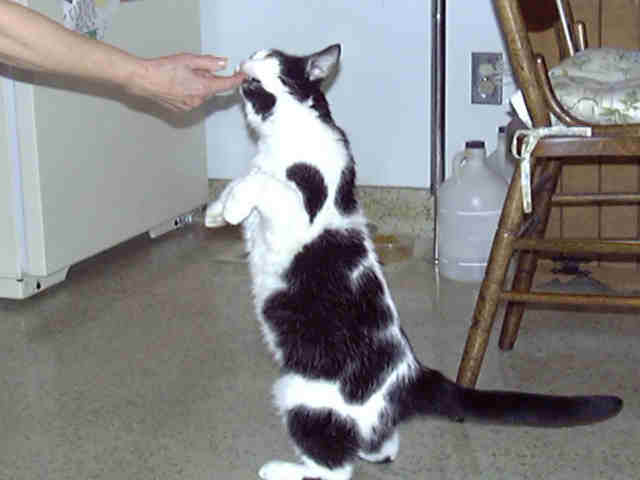
The Life Cycle of Fleas
Understanding the life cycle of the flea is necessary in order to control
it.
The flea has several stages to its life cycle. Adult fleas spend most of
their time on the dog or cat - they must be dislodged to leave since they will
not do so voluntarily.
Despite this, when the flea population on the dog becomes excessive humans
tend to be an acceptable alternative to the flea.
The average life span of an adult flea is probably about 6 weeks - but
fleas can live as long as a year under certain conditions.
A female flea can lay 20 to 28 eggs a day. She may lay several hundred eggs
over her life span. These eggs fall off the pet and develop where they land.
They are small and can even develop in the cracks in wood floors or other
small crevices. A larvae hatches from the flea egg. It takes as few as 9 days
to as long as 200 days to go through its growth stages.
At this time it forms a pupae and waits for the right time to hatch. Fleas
prefer temperatures of 65 to 80 degrees and humidity of 75 to 85 per cent.
This range determines the period of time that fleas are a problem in your
particular area. For some areas of the country, this is all year. In others,
the flea season is relatively short.
It is estimated that for every adult flea found on the pet, there are about
10 developing fleas in the pet's environment.
Fleas have four stages of development: egg, larval, pupal and adult. The life
cycle varies depending on the flea species, temperature, humidity and the
availability of food. The optimum development period from egg to adult is two
to three weeks; however, when conditions do not favor rapid development the
cycle may take several months.
Egg Stage
After each blood meal, female fleas lay four to eight smooth, round, light-coloured,
sticky eggs. Eggs laid on a host can easily fall or be brushed off. High
concentrations are usually present in pet bedding, boxes or kennels.
Larval Stage
Eggs hatch into very small, hairy, wormlike larvae that are whitish with
brownish heads. The larvae are about 1.5 mm long and may grow to 5 mm. During
this time they avoid light and are sensitive to changes in humidity and
temperature.
Flea larvae feed on organic debris, their own cast skins and on dried blood
present in the excrement of adult fleas. Larvae can survive for up to 200 days
in unfavorable conditions and can travel distances of up to 30 cm per minute.
Flea larvae will coil around the nearest object, often carpet fibres, in order
to avoid the suction of a vacuum.
Pupal Stage
In the third stage of development, flea larvae spin silken cocoons covered
with particles of dust, fibres, sand and organic debris. Within this cocoon,
the larvae metamorphose in the shape of adult fleas. They are white in color
at the onset and change to brown before emerging.
Adult Stage
Adult fleas are small, dark brown or reddish brown insects ranging in
length from 1 to 4 mm. Their bodies are flattened from side to side allowing
them to move easily through hair or fur.
Although they are wingless, their stout hind legs are well adapted for
jumping. Fleas can jump a maximum distance of 20 cm vertically and 41 cm
horizontally. Their comb-like, spiny legs make it difficult to detach fleas
from a host.
Adult fleas may remain in the pupal chamber for several months until
favorable conditions, such as increased temperature and carbon dioxide
concentrations, favor their emergence. Vibrations indicating the presence of a
host also stimulate their emergence. This explains why fleas in unoccupied
homes become active as soon as humans or pets re-enter.

How to control Fleas
As part of an over all flea control plan, we highly recommend getting your
pet on an all natural premium food and daily supplement.
Why?
It's because poor quality foods do not provide the necessary nutrients that
are required to develop strong immune systems.
A high quality food will give your pet the right nutrition it needs to
build strong healthy cells and a strong immune system.

Tippy and Alfred's Flea Story
The winter before we started eating the Life's Abundance food and taking
the Daily Supplement, we had a lot of fleas.
Our human friends set off bombs and vacuumed the carpets all the time
trying to get rid of those darn pesky creatures. Plus they had us on this
really toxic stuff called Advantage. Man was it wicked....it worked for a
little while but never got rid of the fleas, they always came back.
And all Dave did was gripe about how expensive it was.
It was embarrassing for them because when company would come over, fleas
would jump up on their legs.
Dave & Jan's social life wasn't too pleasant at that time.
The next fall, they put us on the food and Daily Supplement. That winter,
Dave & Jan did not set off one single flea bomb and did not use the
Advantage.
There simply wasn't a flea problem!
That totally amazed our human friends so they asked Dr. Jane Bicks why this
happened.
She said the Life's Abundance food and Daily Supplement gave us the
nutrition we needed to build a strong, healthy immune system and because our
systems were now a lot stronger....it actually repelled the fleas!
Whatever happened...we just know it worked!
so do your precious furry friend a big favor and try the Daily Nutritional
System out....
You've got nothing to lose....except those darn pesky fleas.......
 Tippy & Alfred's Favorite Dining
Experience here
Tippy & Alfred's Favorite Dining
Experience here
Here's one of Alfred's furry friends Begging for more of
the Life's Abundance Premium Cat Food & Supplement!
Does your dog or cat ask for it's food like this?
If not, then if it was on the Life's Abundance food & supplements,
your pet could act like this at feeding time!!!

The best thing you can do to help your pet live the Longest and
Healthiest Life possible is provide them with a quality Premium food.
You'll feel great by providing your pet with the best....they deserve it!
General Pet Care Tips